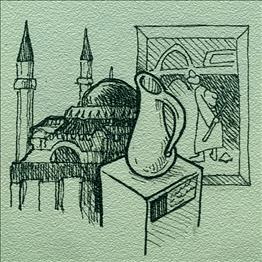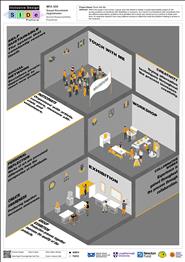Touch with Me

DESIGNED BY:
Emircan Karagöz, Besim Ceylan, Rüya Yağmur Altıntaş, Satuk Buğra Tohumoğlu, Agit Fatih Önal, Eylem Yurtseven, Tuğçe Akgün (SCPAT)
INTRODUCTION:
Numerous projects are being developed on national and international scales to overcome physical barriers related to museums. However, failure to implement developed solutions or check their applications leads to accessibility issues. The project aims at developing an approach that would enable people to participate, communicate with disabled individuals and gain awareness as they build a solution proposal.
In our project development process, problems were discussed with our design partners from two different NGOs, each focusing on a different disability group; accessibility issues in museums were investigated. It has been observed that orthopedically impaired individuals could not access many museums because of problems such as improper use of ramps, inappropriate design of entrances and horizontal/ vertical circulation areas, lack of empty spaces in exhibition areas for their manoeuvres and improper threshold heights at doors. For persons with visual disabilities, following issues were identified; difficulty in perceiving the plan or layout of the space, exhibiting artworks with audio description only, assuming that artwork descriptions in Braille Alphabet would suffice, and lack of tactile surfaces on floorings to guide people in the spaces.
Audio descriptions are not the only way for persons with visual disabilities to perceive objects, as our design partner from the “Six Dots Foundation for the Blinds” stated during our meetings; on the contrary, the importance of perception through many different senses have been emphasised. Within this context, it is learned that tactual sense is used intensively by persons with visual disabilities for perceiving spaces and objects. Although there are some experimental studies focusing on the tactile perception of artworks, our research has revealed that these are not commonly used practices for museums.
After determining the problem, because persons with visual disabilities face problems about the accessibility of artwork more frequently, the focus of the study has been directed on this issue. In this regard, it was decided that the artwork which we will be made accessible for the case impairment group should reflect numerous interpretations of this piece, just like general visitors may access to multiple interpretations of artworks and can also comment on them. For this reason, we decided to design a method for organizing interactive and participative workshops for people, and museum staff members or experts interested in accessibility, where they can be a part of this translation process.
INTERACTIVE AND PARTICIPATIVE WORKSHOPS
Many museums organize inhouse workshops. However, the workshops which are defined by this project intend to involve voluntary participants who have sight or have visual impairments, artists, art historians, curators and persons with visual disabilities as consultants, as the participants of that workshop to collaborate on the possible ways for increasing the accessibility of artworks for the persons with visual disabilities. The workshops' final outcomes that focus on tactile perception will be relief copies of the original works exhibited at museums. Within this framework, two paintings of Bedri Rahmi Eyüboğlu, named "İki Balık" and "Aşık Veysel", were studied as a case to find out the possible ways of exhibiting artworks as replicas with open to access. The workshops are planned to be organized twice in a month (biweekly). One of these studies is intended for children, and the other is planned to include participants of all ages.
- On the first day of the three-day workshop, a presentation on visual impairment and accessibility will be delivered -on the Friday on the first week. The first contact between the participants and the lives of persons with visual disabilities will thus be built.
- On the second day, there will be a study on information about materials, the nature of tactile perception and the ways of perceiving tactual differences.
- On the third day, a participatory study will be carried out where the participants will make their own relief/embossed/tactile replicas of the artworks exhibited at museums.
The workshop outcomes will be exhibited for two weeks, and visitors of the museum will be able to experience the artworks by touching them. Together with these studies, persons with visual disabilities will be enabled to perceive different interpretations of artworks in one hand, on the other hand, the awareness among the participants and the society will be increased as well through the awareness of the workshop itself. The purpose of these workshops being organized for children once a month is to learn mainly by touching. The participation of children in a workshop that will help them become more aware individuals in the future, learn artwork, and create a piece that will be exhibited at the museum will contribute to the continuation of museum culture for future generations and develop an understanding on accessible spaces.
In conclusion, within this project, the pieces produced by voluntary participants under experts' guidance during the workshops organised at museums will be exhibited temporarily with different interpretations. The replicas of the artworks made accessible by experts will also be presented to the visitors.
